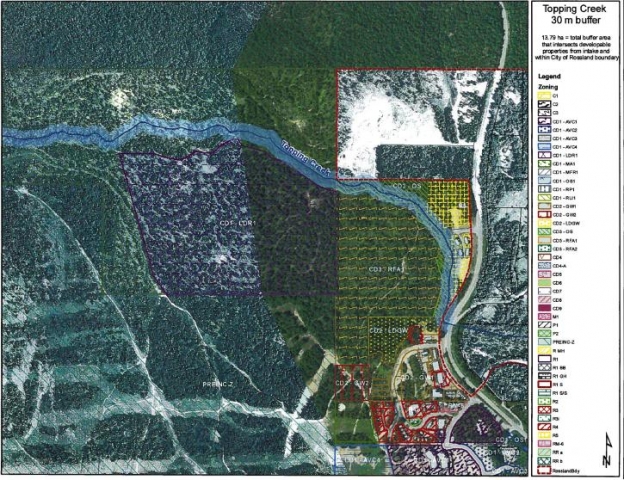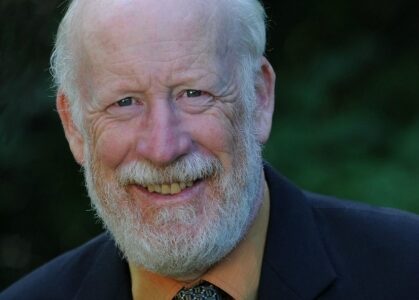How close is too close for development on Topping Creek?
How close is too close when it comes to development near our city’s drinking water sources? City Council discussed this issue, specifically dealing with Topping Creek (one of several creeks that provide Rossland’s drinking water supply), during a Committee of the Whole meeting this past Monday night. In the end, they opted to pass a recommendation to the next council meeting to increase the riparian setback zone on Topping creek to thirty metres.
The issue will now come back before council during a regular council meeting during which councillors will discuss and vote on modifying the existing regulations in the OCP–specifically Schedule F, Best Management Practices for Topping Creek.
The issue arose from a Committee of the Whole (COW) meeting on June 28th in which the COW made the recommendation which was later adopted by council on July 12th for staff to report on the implications of increasing the riparian setback of Topping Creek from 15 to 30 metres.
The recommendation and report back from City staff discussed this past Monday night was to adhere to the existing regulations in the OCP.
The current regulations set flexible regulations for setback restrictions based on identification of riparian values by certified professionals in compliance with provincial and federal regulations. A 15 meter setback is the minimum under the current regulations. That can be modified, however, depending on how the terrain’s contours may affect the riparian values of the land around the creek. Both the Ministry of Environment and Department of Fisheries and Oceans also receive all development which occurs in such sensitive habitat as the land around Topping Creek.
The majority of the land that would be affected if a 30 meter no-build setback was introduced around the creek does not have residential zoning. The exception is the Creekside 88 development. Moving to a 30 meter setback would bring portions of the existing Creekside development into legal nonconforming status. The most significant impact on the development, however, would be on the southern end of that development’s lands; its buildable footprint would be reduced by75% from .83 has to roughly .2 ha. That is not necessarily to say development could not happen within that area, however; but it would mean that the developer would have to come back to the city to request a variance.
Two of the biggest threats to the Topping Creek water supply as it stands would not be mitigated by a 30 metre setback: the potential for a spill on the highway and the threat from the open pit quarry mine just north of the city.
The quarry sits outside of the City’s northern boundary and any changes to Rossland’s OCP would not apply to that land.
This is of particular concern to the City. As recently as 2007, the Topping Creek intake had to be shut down due to high turbidity in the water as a result of activities in the quarry. City Planner Mike Maturo noted that this issue has been a source of discussion for Area B councils on how to address the issue which directly affects Rossland’s water source yet the City presently has no control over.
“We could have the nicest language in the world for the fringe of the OCP but we’re still dealing with a 32 acre mine and the Ministry of Mines regulating it.”
While the report recommended sticking with the existing setbacks, several councillors would prefer the city to err on the side of caution to ensure long term protection of Rossland’s water supply. Kathy Moore spoke strongly in favour of expanding the setbacks to 30 meters.
“I think the setback of our creeks is extremely important…The fact that we’ve been grandfathered in isn’t a reason not to do it. We can’t control what’s outside our boundaries. To me that’s not a reason not to do this. Creekside is great example of where our OCP did not save the creek. There was a lot of degradation in the Creekside development; not the built part but when they started to expand. Blue Eyes Swamp was heavily impacted and the 15 meter setback was significantly impacted.
“It was quite sad. Topping Creek was also encroached on. Putting a 30 meter setback in which would require the landowner to ask for variance would just give us a bit of extra protection for our creeks. I think we need to do that. We need to be cognizant that the water we have right now might not be the water we have in the future. We should protect our water wherever we get the opportunity to. I won’t be in favour of this recommendation.”
Councillor Andy Stradling also voted against the motion, citing a desire to see a completed watershed management plan before making such decisions.
“The document missing for me is the Watershed Management Plan. If this council had a document that recognized the importance of the watershed to our city’s future and a plan built around that which included Topping Creek as a source, I think this decision would be a lot easier. Right now it looks like council versus development as opposed to council versus protection of the water supply as might be defined in a Watershed Management Plan. The protection I’m looking for is a little bit more than is currently available with a 15 meter riparian zone.”
The original motion to stick with the guidelines as is was defeated with councillors Kathy Wallace and Jill Spearn in favour.
A recommendation made by Moore was ultimately passed 5-2 with Councilors Wallace and Spearn voting against it: City staff was directed to implement a 30 metre setback on Topping Creek with specific exceptions for Red Mountain ski operations. Staff were also directed to work with the RDKB to establish further protections of the land within the regional district.
That recommendation will come before council at their next regular meeting for discussion and voting.


























